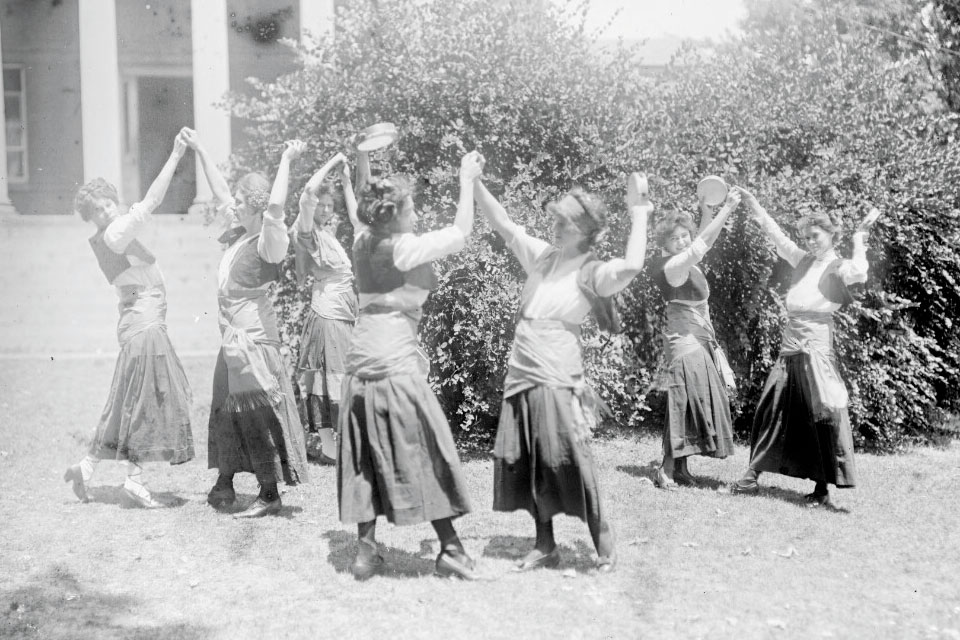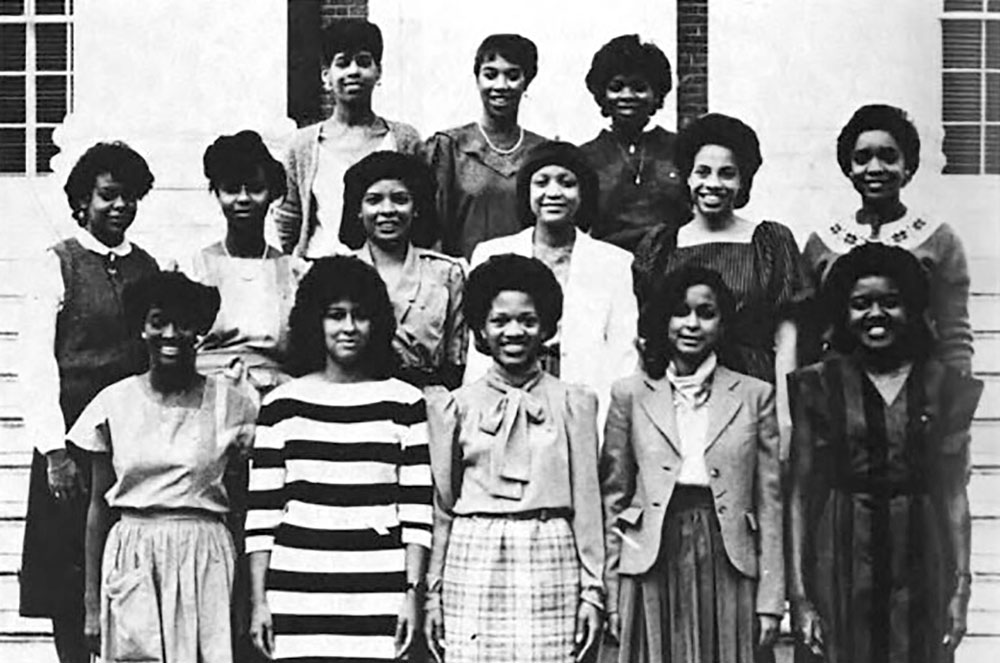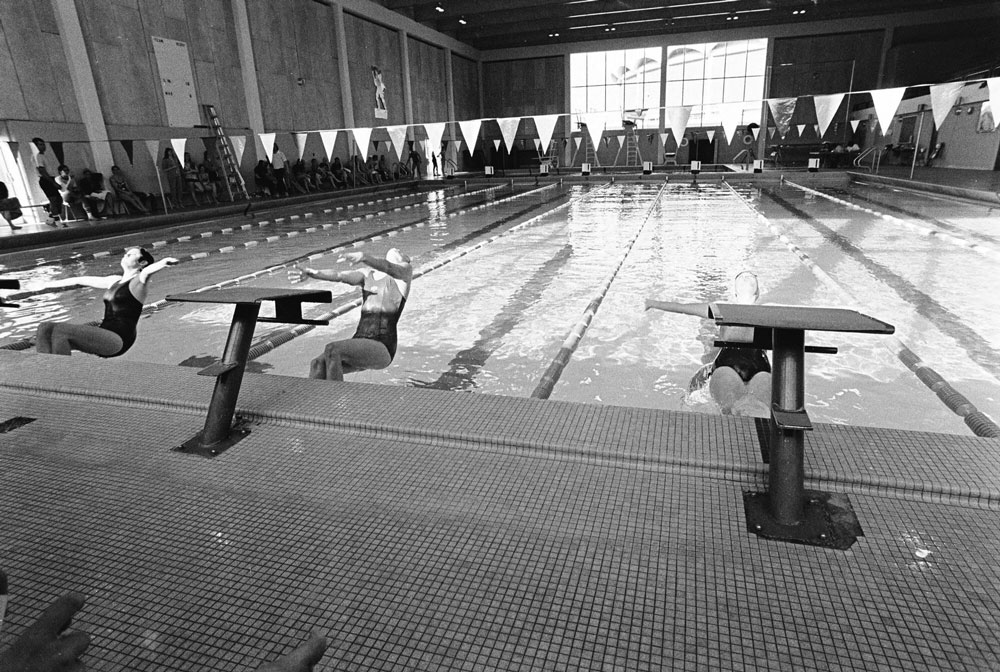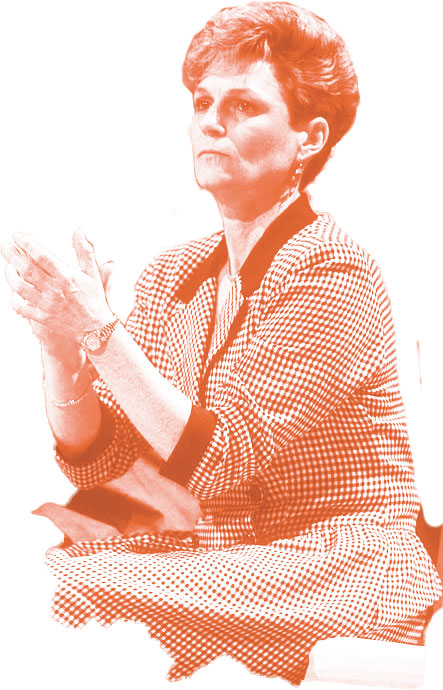How women found their place at Mr. Jefferson’s University
“By God, I Think They’re Here to Stay,” declared the Cavalier Daily headline in September 1970. Next to the story about the “young lovlies” [sic] who were moving in as part of UVA’s first truly coeducational class, incoming first-year student Rebecca Wheeler (Col ’74) was featured in a large black-and-white photo.
“We were quite the spectacle,” says Wheeler, who went by Becky Sorrells at the time. She still recalls the forest-green velvet miniskirt she was wearing that day as she lugged two suitcases into Webb House and the photographer who approached her. “I remember him saying something like, ‘We’re documenting the arrival of women on campus.’”

But long before the Class of 1974 arrived, tens of thousands of women had already moved in and made their mark here. They often weren’t making headlines, but by 1970, some 15,000 women had professional, graduate or undergraduate degrees from UVA; another 15,000 had diplomas or degrees in nursing. They’d celebrated high achievements despite low expectations, led student organizations and competed on men’s varsity teams.
Women’s history at UVA is a complicated one—tied up from the beginning in Thomas Jefferson’s own intention that it wasn’t designed for “female education.” For decades, leaders pushed back on proposals to let women attend what was sometimes called the Gentleman’s University. UVA was among the final U.S. public institutions to go coed.
The tone of the University certainly changed in 1970 when women finally arrived by the hundreds. But the full history of women studying at UVA, which began 90 years before, is often forgotten. Phyllis Leffler, professor emerita in UVA’s Department of History, contends it should be recognized, too.
“By not acknowledging all the women who came before in all the different kinds of programs, in my view, it simply reinforces this notion of a kind of all male, aristocratic Southern kind of school,” she says. “It’s still part of the lore.”
In 2020, UVA marks two milestones: the 100th anniversary of white women being able to enter graduate and professional programs and the 50th anniversary of full coeducation.
“This is a moment where we could tell the story better,” says Abby Palko, director of the Maxine Platzer Lynn Women’s Center at UVA. “Tell the story in a way that shows there is a more progressive spirit at UVA than people have realized—and maybe we can keep building on that.”
Here’s a look back at all 140 years of women at UVA, and how women made Mr. Jefferson’s University a place for themselves, too.

“It took them one semester to find out that I was not after a husband and another semester to find out that I could do the work.”
—Elizabeth Nelson Tompkins (Law 1923), the law school’s first female graduate
The first women to “horn into” classrooms
In their full-length ruffled skirts, some of the female members of the University Normal School, Session 1880, posed for a picture with their male counterparts on the steps of the Rotunda. The summer school students were all teachers and mostly women—312 of the nearly 500. But they weren’t extended the same opportunities. Men earned credit; women did not.
“It was like, ‘We’ll offer you some additional training, but this is not going to allow you any kind of a UVA degree or credential,’” Leffler says.

On top of policies that held women back academically, student publications warned against women in their words and images. Professors and male students were openly hostile.
After the General Assembly passed a bill letting white women into graduate and professional programs, a January 1920 editorial in College Topics, the precursor to the Cavalier Daily, fretted over the unspecified “evils” of coeducation. A cartoon in the 1921 edition of Corks & Curls compares the incoming female classmates to a naked Eve and a flock of hens, among other images.
In April 1967, Cavalier Daily editors wrote: “We look with horror upon the prospect of a large-scale female invasion, other than for the purposes of a party weekend, of these traditionally male Grounds.”
Rhetoric like this didn’t make it any easier inside the classroom. “It took them one semester to find out that I was not after a husband and another semester to find out that I could do the work,” said Elizabeth Nelson Tompkins (Law 1923), the law school’s first female graduate, in a 1980 interview with Virginia Law Weekly.
Constance Page Daniel (Col 1931) remembered the stomping. “I’d walk into a classroom and the students would all stomp. Stomping was their signal of derision,” said Daniel in a 2011 interview with Virginia Magazine. “They didn’t want coeds at the University, and I was a woman, and I was at the University, and I had no business there.”
Even when they were welcome, women’s manner, more than their scholarship, was noted. Before getting to UVA, Lois Corinne Ketcham Carwile (Col 1923, Grad 1924, 1927) was a top student. Her professor at The Woman’s College in Richmond called her “the most gifted young woman” he’d ever taught. As a summer school student in 1919, she lived on the Lawn, according to a UVA newspaper covering the summer session.
Eventually, as a full-time student, Carwile became UVA’s first female graduate student in physics. Her dissertation explored “wave-lengths in the absorption spectrum of nitrogen peroxide.” But when longtime physics professor Frederick L. Brown mentioned her in a history of UVA’s physics department, he didn’t focus on her academic success. “Her most exemplary behavior and demeanor avoided unkind remarks about women trying to horn into a man’s school,” he wrote.
Despite the obstacles, many women left UVA with good memories. “It was a mixed bag,” Leffler says. “A lot of women were thrilled to be at the University of Virginia, and what they mostly remember is how special it was to be able to be students here. But many of them had experiences in which they were made to feel very much like outsiders.”
As more women enrolled at UVA and became faculty members, and academic programs evolved to meet their demands and requirements, the reception improved, Leffler says.
“There were things that happened, absolutely,” says Ann Brown (Col ’74, Law ’77), part of UVA’s first class of undergraduate women, such as a professor who liked to tell sexual jokes. “But the vast majority of experiences I had as a student in the classroom and in extracurricular life was very positive and very supportive, welcoming and encouraging of women.”
Roadblocks, however, were far more substantial for Black women. With some notable exceptions, including Barbara Starks Favazza (Med ’66) and Vivian Pinn (Med ’67)—the first and second Black women to graduate from UVA’s medical school—they were explicitly excluded from the University
for decades.
Sarah Kelley (Nurs ’65) skipped two semesters in high school and graduated at age 16 in the mid-1950s. She assumed she could enter UVA’s three-year nursing diploma program to pursue her lifelong dream of becoming a nurse. But when she inquired about enrollment the woman told her, “Even if you were 18, we don’t take Blacks,” Kelley remembers.
She eventually completed UVA’s licensed practical nursing program for Black students and served as her class president. Still, the Grounds never seemed like a safe gathering spot for her. Though she worked for years at the hospital, becoming its first Black chaplain resident, and lived just blocks from Grounds, Kelley never visited the Lawn or Rotunda until she was 78, when she’d been invited to bless the new Memorial to Enslaved Laborers. “I wept,” she says.
In 2019, Kelley and other so-called Hidden Nurses, who graduated from the LPN program, were finally recognized as UVA alums. Says Kelley: “It felt good after being abused, in a way of speaking.”
Making their own fun
While they may have come to UVA to learn, it wasn’t just about academics for the earliest female students. With curfews and chaperones in the early days, their student life was restricted, but women found ways to socialize. And while men might have grumbled about them in the classroom, they didn’t seem to mind them at the parties.
“If you were a woman and could breathe, you usually had four or five men following ’round behind you,” said Daniel, the 1931 graduate.
By the 1920s, opportunities began to emerge for women specifically, according to Leffler’s research. Both the Women Students Self-Government Association and the Lychnos Society, an alternative to the Raven Society, opened. So did the Co-Ed Room, where women played cards, ate lunch, enjoyed afternoon tea and gathered for meetings. Chi Omega sorority was established in 1927, followed by Kappa Delta in 1932.
Janet Lauck Blakeman (Law ’57), one of two female law students when she started law school, remembers going to parties at Fry’s Spring Beach Club, attending football and basketball games, and spending long hours studying in the law school library, then in Clark Hall.
“I loved law school,” she says. “Overall, I thought the atmosphere was great. Yes, to be sure, some people weren’t. But they weren’t your friends.”
For a bit, Blakeman lived in Mary Munford House, which opened in 1951 for women, but she found more freedom when rooming with fellow female students in apartments or houses, which only came with the approval—and under the watchful eye—of the dean of women.
At one house on Rutledge Avenue, Blakeman recalls with a laugh, she and her roommates got a lecture from the dean of women because one of them was entering her basement apartment through a separate entrance instead of through the main house. “She wasn’t supposed to have visitors down there, let me put it that way,” Blakeman says. “Did we care? No.”
As UVA welcomed 450 female undergraduates in 1970 with coeducation, women quickly claimed their space socially. The Virginia Women’s Chorus and Virginia Belles formed. And it was a heyday for Greek life; more than 10 sororities were established, including three historically Black ones.
As a member of Alpha Kappa Alpha in the early 1980s, El-Rhonda Williams Alston (Col ’85) dove into her sorority’s community service work, leading an effort to read assignments to visually impaired students.

On weekends, she’d cram into Newcomb Hall for DJ-led dance parties with her sorority sisters and 500 or 600 other Black students. Tickets were $1, she says, and the money was used to fund community service projects.
Alston remembers plenty of examples of racism while she was a student, but also a feeling of empowerment. “I went anywhere and everywhere I wanted to go,” she says. “And if I felt like somebody didn’t want me to be there, I made it my business to be there.”
As women settled in, no longer constrained by curfews or limited opportunities, new ways to spend their years at UVA unfolded before them.
“A lot of people like to think of UVA as a very strict institution,” says Sandra Menendez (Col ’15), who spent a lot of her time at UVA’s Women’s Center and as a peer adviser. “Thomas Jefferson quotes are everywhere. And you wear the orange and blue and it’s the guys in ties and the girls in pearls, and you have these traditions. But … the UVA that I went to and the UVA that I see is far more moldable, and that, I think, is done by the students who are there.”

Blazing trails in UVA athletics
Women’s sports at UVA only began to grow once Title IX went into effect in the 1970s. But women found ways to compete before that.
Mary Slaughter (Educ ’54) in the 1950s and Mary Brundage DeLashmutt (Nurs ’67) each earned spots on men’s varsity teams and also were the first two women to compete in the Atlantic Coast Conference.
Slaughter, a Charlottesville native, was a top tennis competitor. Her father, Edward “Butch” Slaughter, a longtime UVA coach, professor and intramural director, found a space for her to study and play at UVA. She joined the freshman team in 1952 and moved up to the varsity team in 1953.
Her teammates didn’t mind playing with her; they knew she could compete, she says. And her father helped pave her way. When the team traveled, he called ahead to ensure somebody would meet her to take her to a ladies’ room. “There was nothing for women,” she says.
Slaughter became the first woman to earn a UVA varsity letter. But, after two years on the tennis team, the ACC ruled that women couldn’t compete on men’s teams, and Slaughter transferred to what is today the University of North Carolina at Greensboro.
In the 1960s, DeLashmutt had a harder time fitting in. The long-distance swimmer, among the top in the world, was placed on the men’s swim team. She was just thankful she had a place to swim all year; Memorial Gym had the only indoor pool, and it was off-limits to women except on Friday nights.
Still, without a women’s locker room, DeLashmutt had to wear her suit underneath a jacket and rush through a men’s shower room to get to the pool. “I’m sure some of the men really resented that I was there, particularly when I beat some of them,” she says.
Life outside the pool was stressful. Her membership on the team garnered national coverage. “I’d walk into the cafeteria and see people point,” DeLashmutt says. Some coaches refused to compete against her.
“The thing that I hadn’t known to think of was the ‘freak factor,’” she says.
During her single season, DeLashmutt garnered enough points to letter on the varsity team and placed in every meet she competed in. At the start of the season, she’d been declared eligible, but in February 1966, the ACC ruled that DeLashmutt and other women could no longer compete. Law students offered to appeal, but she stepped away.
“I didn’t think it was worth the stress and the tension to try to go to battle,” she says. “I knew how hard it had been the first year.”
No serious effort to launch women’s sports at UVA came until the early 1970s with coeducation, and it was still met with raised eyebrows and stereotypes. An illustration in The Declaration attached to a story about a 1975 softball tournament portrayed female athletes as overweight and unattractive.
Bev Marcum (Grad ’74), who coached UVA’s team at the tournament, had already come to expect that kind of coverage. A few years earlier, Marcum started a club field hockey team, a precursor to UVA’s varsity team, and remembers a Cavalier Daily story that said the team was “man-handled” in a game they lost by just one point.
“It was like we were swimming upstream,” she says.
Title IX funneled new support to women’s athletics, fueling programs and scholarships. In 1981 and 1982, the women’s cross-country team won back-to-back NCAA national championships, the second and third ever for UVA.
But even when women had their own varsity teams, they faced an uphill battle. Longtime women’s basketball coach Debbie Ryan (Educ ’77) remembers the work required to get funding for sports bras in the early 1980s.

Then-Associate Athletic Director Jim West denied her first request, so Ryan gathered medical research that demonstrated why female athletes needed the bras. Then she went to UVA’s other coaches with a petition. She brought in the research and the petition, which included signatures from football coach George Welsh and men’s basketball coach Terry Holland, to Dick Schultz, then UVA’s athletic director.
Schultz shut her down at first, saying UVA couldn’t afford them. When Ryan shot back that they paid for jock straps, Schultz pointed out those cost just $5 each. Bras were $32. Ryan got up to walk out.
“I get to the door and I say, ‘So if jocks were $32 and bras were $5, would you give men jocks?’” Ryan says. “And they said, ‘All right, all right. You can have them.’ And that’s how
it happened.”
Soon other women’s coaches heard of Ryan’s victory, including famed basketball coach Pat Summitt at the University of Tennessee, and sought her advice. “And they went in and got them too for their whole department,” Ryan says.
_10.18.jpg)
Today, women are leading decisions about sports at UVA. Field hockey player Anzel Viljoen (Col ’20) served as president of the Student-Athlete Advisory Committee during her fourth year and worked with Carla Williams, UVA’s first female athletic director, who took over in 2017. “I definitely would say that I didn’t feel discriminated against as I’m sure the early women did,” Viljoen says. “People respected me, and they would listen to me. And I think it’s also nice because we have a female AD now, and she’s a boss.”
‘Natural progression’: Taking the lead
Women found ways to lead at UVA even as many University institutions shut them out. In 1931, Marion Boyd Crockett (Law ’32) was the first woman elected to the Virginia Law Review board. Two women—Frances Ames (Law ’43) and Flora Kirley (Law ’43)—were editors of the law review’s January 1943 edition.
Even without an official title, women spoke up when change was needed. With only one bathroom in Gilmer Hall for women, Marcum remembers when she and her fellow classmates declared another restroom in the building for themselves around 1969. “We occupied a men’s room,” she says.
Leadership opportunities grew in 1970. Brown, the 1974 alumna, credits women’s rapid integration into University life to Admissions Dean Ernie Ern, who populated the first class of women with students who were active in high school.
“The goal, in his mind, was to find women who would just naturally fan out across the Grounds and get involved in student activities,” says Brown, who became the first woman tapped for the IMP Society and a founder of The Declaration, serving as its first editor-in-chief.
Women started knocking out other firsts as they moved up the ranks within student groups. The Cavalier Daily elected its first female editor-in-chief, Marjorie Leedy Green (Col ’77), in 1976. In 1981, Nancy Lyons Callahan (Engr ’82, Darden ’84) became the Honor Committee’s first female chair. Carole Kirkland Ramser (Col ’85, Educ ’89) won election as the first female Student Council president in 1984.
“To a certain extent, I think the women at that time did feel like we were still trailblazing, but not in any extreme way,” Callahan says. “Not nearly like the first women that were there who had a much harder time. We just thought this was the natural progression of things.”
For more recent students, women’s issues are the same—and different. In 2019, they successfully won funding for free pads and tampons in public bathrooms.
Just like generations of women before them, they’re mindful of the dangers of sexual assault and violence, but the topic is no longer relegated to quiet conversations as they prepare for a night out. Efforts like the UVA Women’s Center’s annual Clothesline Project, where sexual assault survivors share their experiences through art on the Lawn, put the subject front and center. “That was a really empowering way to know that they are being heard,” says Jieru Shi (Com ’20), who was active in Women’s Center programs and the Asian Student Union.
Now, when students consider women’s issues, the discussion dives deeper than gender, but into topics of race, sexual orientation and religion. In the classroom, occasionally the lone Asian American woman, Shi felt that others listened to her even more because of her perspective.
In 2020, 140 years after schoolteachers came to UVA to study, a century after white women could enter some UVA programs, and 50 years after coeducation became the rule, recent alumnae say there’s plenty of work to be done on issues of gender, but they have a loud and clear voice at the table.
“I don’t think I ever felt I was unheard,” Shi says of her time at UVA. “Period.”